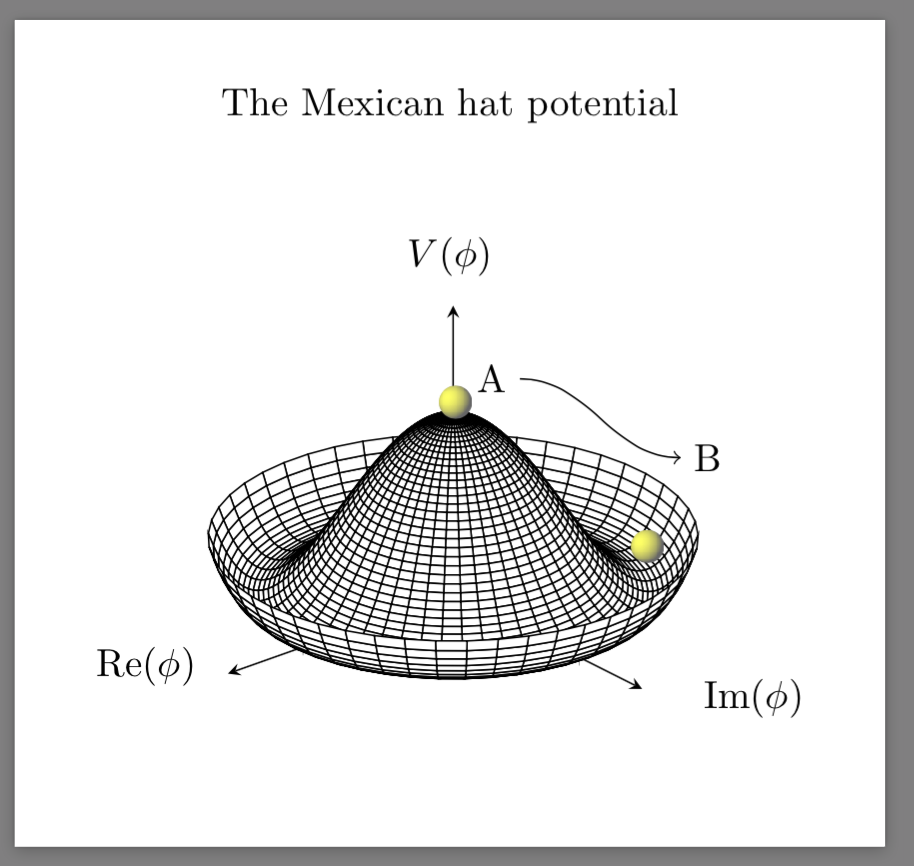In this text sombrero model and Mexican hat potential are the same thing. The big question is where that Mexican hat or sombrero is forming. Does it form out from the particle, or in the particle? If those Mexican hat potentials impact inside the particle they send wave movement that could explain the aging of the material.
When those potential fields impact inside the particle. They send wave movement. And that wave movement takes part of the particle with it. That explains why only particles with mass can turn to wave movement. The Higgs field pulls part of them in it. And the thing that supports this model is the fact that massless particles cannot turn older. The only speed that those particles have is the speed of light. And that thing causes time dilation.
So photons never turn old. The thing is that aging is connected with the mass of the particle. The particles with mass can slow, and they turn to wave movement. And that tells that interaction between the particle and Higgs field causes aging by "stealing energy from particles". The particles that don't have interaction with the Higgs field are timeless.
Higgs boson is an extremely short-term particle. The particle divides less than a nanosecond. And it makes observations about that particle extremely hard. But the question is how a particle that spin is zero can give energy to W and Z bosons and other sub-particles that it releases while it divides.
The answer could be in the impacting sombreros. The sombrero model is the model where the power field turns to material and particles. So the Higgs field in the particle could look like a sombrero. When the Higgs boson is forming that thing is a high-energy area in the Higgs field.
When the Higgs boson divides, that thing causes a shockwave in the Higgs field. The point where Higgs boson was turning lower energy level. Then Higgs field travels to that point and impacts in the middle of the place, where the Higgs boson existed.
So we can think that two sombrero-looking power fields anchor the Higgs boson in the static position that remained for a very short time. And then those two sombrero-looking energy fields impact at the point where the Higgs boson existed. So could that thing be the thing that we can call dark energy?
The key is how Higgs boson gives mass to the material. There is the possibility that the superstrings are the smallest form of material. Are like spiral or screw-looking power fields. And the Higgs field can make a plaque on those superstrings. That plaque could explain why the Higgs field is pulling the energy field.
The plaque around those superstrings that are forming a whisk-looking structure on the shell of particles is the higher energy form of the Higgs field than the field around the particle. And that causes a situation in which the Higgs field travels out from the particle. When the particle spins it transfers kinetic energy to those superstrings and Higgs field plaque. The energy travels out from the particle because its energy level is higher than the Higgs field. And maybe that energy channel can explain dark energy as the energy transfer between particles and the Higgs field.
When we are looking at the sombrero model where the Higgs boson is like the ball on the sombrero that is the Higgs field, we forget one very important thing. We live in a 3D universe, where almost all particles are 3D structures. If we think that the Higgs field that gives mass to particles is like a sombrero, we forget that there are two sombreros on opposite sides of particles.
And in the middle of particles that have mass, those two opposite sombreros impact. If those two sombrero-looking power fields impact in the middle of the particle. They should send wave movement. That wave movement from those impacting sombrero-shaped energy fields can explain why particles turn to wave movement or vaporizing.
The Higgs field can also explain why there is dark energy in the universe. We can think of the particles with mass as the bubbles that are hovering above the Higgs field. The Higgs field forms the channel between particles and the Higgs field. And when photons or other massless particles hit those channels or quantum pillars. They cut those pillars or quantum channels into two parts.
When the photon passes the quantum pillar, that pillar will impact back to its entirety and in that case, the pillar sends wave movement. When that quantum channel slams back to close, that thing causes an energy impact that is very weak and different from other energy impacts. That thing forms the wave in the Higgs field.




No comments:
Post a Comment
Note: Only a member of this blog may post a comment.